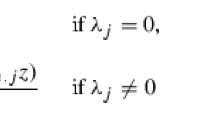Abstract
Finite volume fitted difference schemes are constructed for one and two-dimensional air-pollution models with degenerate vertical diffusion. A weak formulation of the equations imposes the boundary conditions naturally along the boundaries, where the equation becomes degenerate. Then, we establish the energy well-posedness of the initial-boundary value problems. We prove minimum principle and show that the solution cannot attains its minimum on the boundary of degeneration and this allows us to control the positivity of its solution. To overcome the degeneracy of the vertical diffusion, we perform a local fitted space discretization. Non-negativity of numerical solutions is proved. Numerical experiments are discussed. As examples, we apply the method to study the pollution concentration to Monin–Obukhov types atmospheric models.






Similar content being viewed by others
References
Albani RAS, Albani VVL, Migon HS, Silva Neto AJ (2021) Estimation of atmospheric emissions by an adaptive Monte Carlo Markov chain method. In: 26th ABCM international congress of mechanical engineering—COBEM
Albani RAS, Albani VVL (2020) An accurate strategy to retrieve multiple source emissions in the atmosphere. Atmos Environ 233:117579
Arora U, Gakkhar S, Gupta RS (1991) Removal model suitable for air pollutants emitted from an elevated source. Appl Math Model 15(7):386–389
Arya SP (1999) Air pollution meteorology and dispersion. Oxford University Press, New York
Chernogorova T, Valkov R (2011) Finite volume difference scheme for a degenerate parabolic equation in the zero-coupon bond pricing. Math Comput Model 54:2659–2671
Chernogorova T, Vulkov L (2015) Fitted finite volume positive difference scheme for a stationary model of air pollution. Numer Algorithms 70(1):171–189
Cota CP, Tirabassi T, Vilhena MT, Moreira DM (2012) A general formalization for pollutanr dispersion in the atmosphere. J Eng Math 74:159–173
Quang D, Van Luoc N (1994) Numerical solution of a stationary problem of air pollution. In: Proceedings of NCST of Vietnam 11–23
Quang D, Ehrhardt M (2006) Adequate numerical solution of air pollution problems by positive difference schemes on unbounded domains. Math Comput Model 44(9–10):834–856
Dimov I, Georgiev K, Ostromsky TZ, Van Der Pas RJ, Zlatev Z (2004) Computational challenges in the numerical treatment of large air pollution models. Ecol Model 179(2):187–203
Dimov I, Kandilarov J, Vulkov L (2018) Numerical solution of direct and inverse problems for degenerate parabolic equations with concentrated sources. AIP Conf Proc 2048:030014
Dimov I, Kandilarov J, Vulkov L (2021) Numerical identification of the time dependent vertical diffusion coefficient in a model of air pollution. Stud Comput Intell 961:79–89
Dimov I, Zlatev Z (2006) Computational and numerical challenges in environmental modelling. Elsevier, Amsterdam
Faragó I, Horváth R, Korotov S (2011) Discrete maximum principles for FE solutions of non-stationary diffusion-reaction problems with mixed boundary conditions. Numer Meth PDE 27(3):702–720
Faragó I, Korotov S, Szabó T (2010) Non-negativity preservation of the discrete nonstationary heat equation in 1D and 2D. Aplimat J Appl Math 3:60–81
Hosseini B, Stockie JM (2017) Airborne contaminant source estimation using a finite-volume forward solver coupled with a Bayesian inversion approach. Comput Fluids 154(1):27–43
Kandilarov J, Vulkov LG (2021) Determination of concentration source in a fractional derivative model of atmospheric pollution. AIP Conf Proc 2333:090014
Kumar P, Sharan M (2010) An analytical model for dispersion of pollutants from a continuous source in the atmospheric boundary layer. Proc R Soc A 466:383–406
Lin JS, Hildemann LM (1997) A generalized mathematical scheme to analytically solve the atmospheric diffusion equation with dry deposition. Atmos Environ 31:59–71
Matus P (2002) The maximum principle and some of its applications. Comput Methods Appl Math 82:50–91
Marchuk GI (1986) Mathematical modelling in environmental problems. In: Studies in mathematics and applications 16, North Holland
Monin AS, Obukhov AM (1954) Basic laws of turbolent mixing in the ground layer of the atmosphere. Doklady Akademii USSR 151:163–172
Oleinik OA, Radkevic EV (1973) Second order differential equations with non-negative characteristic form, Rhode Island. Plenum Press, AMS, New York
Pasquill F (1961) The estimation of the dispersion of windborne material. Meteorol Mag 90:33–49
Smith FB (1957) Convection-diffusion processes below a stable layer. Meteorological Research Committee 1048 and 10739, London
Stockie JM (2011) The mathematics of atmospheric dispersion modeling. SIAM Rev 53(2):349–372
Tayler AB (1986) Mathematical models in applied mathematics, Oxford Appl. Math. Comput. Sci. Ser. Clarendon Press, Oxford
Vázquez L, Velasco M, Vázquez-Poletti JL, Llorente IM, Usero D (2018) Modeling and simulation of the atmospheric dust dynamics: fractional calculus and cloud computing. Int J Numer Anal Model 15(1):74–85
Wang S (2004) A novel finite volume method for Black-Sholes equation governing option pricing. IMA J Numer Anal 24:699–720
Wang S, Shang S, Fang Z (2014) A superconvergence fitted finite volume method for Black-Sholes equation governing European and American options. Numer Meth Part Differ Equ 31(4):1190–1208
Acknowledgements
This research is supported by the Bulgarian National Science Fund under Bilateral Project KP/Russia 06/12-2020 and partly by FNSE-03.
Author information
Authors and Affiliations
Corresponding author
Additional information
Communicated by Vinicius Albani.
Publisher's Note
Springer Nature remains neutral with regard to jurisdictional claims in published maps and institutional affiliations.
Rights and permissions
Springer Nature or its licensor (e.g. a society or other partner) holds exclusive rights to this article under a publishing agreement with the author(s) or other rightsholder(s); author self-archiving of the accepted manuscript version of this article is solely governed by the terms of such publishing agreement and applicable law.
About this article
Cite this article
Koleva, M.N., Vulkov, L.G. Positivity-preserving finite volume difference schemes for atmospheric dispersion models with degenerate vertical diffusion. Comp. Appl. Math. 41, 406 (2022). https://doi.org/10.1007/s40314-022-02083-y
Received:
Revised:
Accepted:
Published:
DOI: https://doi.org/10.1007/s40314-022-02083-y




